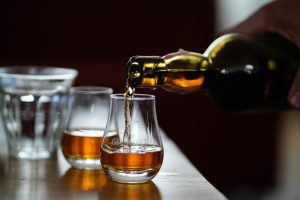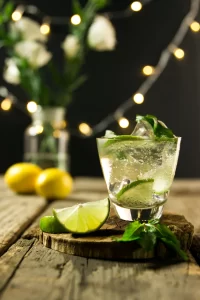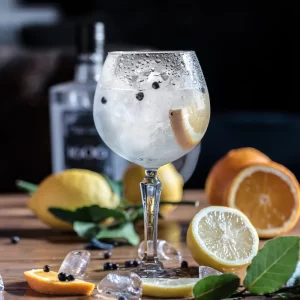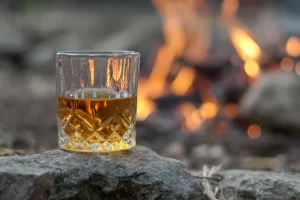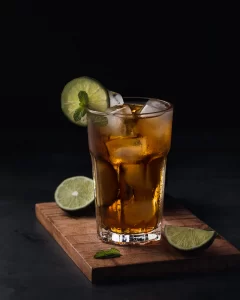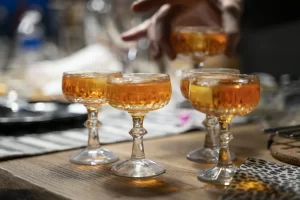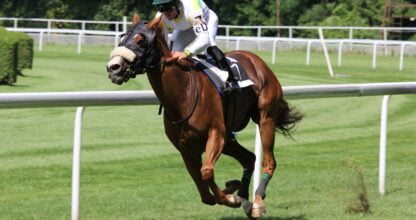Bees & Honey: A Look into Honey Spirits & Why Bees Are So Important to Distilling
In the world of distilled spirits, there’s a hidden gem that might not be on everyone’s radar: honey spirits. These unique and often underrated beverages offer a delicate sweetness and complexity that can elevate your drinking experience. Today, we’re going to cover what honey spirits are, who produces them, how to savor them, and the critical role pollinators play in the world of distilled beverages. Let’s jump right in.
What Are Honey Spirits & How Are Honey Spirits Made?
Honey spirits, like other spirits, are a concentrated alcohol crafted through a fermentation and distillation process that incorporates honey as a primary ingredient. Here’s a simplified overview of how honey spirits are made:
Ingredients & Honey Selection
The first step in making honey spirits is selecting the type of honey to be used. As we’ll cover later on, the choice of honey can significantly impact the flavor of the final product. Other ingredients, such as water and yeast, are also prepared. The quality of water used in the process is also essential since it affects the overall taste.
Fermentation
Honey is mixed with water to create a honey solution, known as a “must.” The ratio of honey to water can vary depending on the desired sweetness and strength of the spirit. Then, yeast is added to the must. The yeast consumes the sugars in the honey, converting them into alcohol through fermentation. This process typically takes several weeks to complete and can vary in duration depending on the recipe and desired alcohol content.
During fermentation, the yeast produces alcohol and various flavor compounds, contributing to the complexity of the spirit.
Distillation
After fermentation, the liquid, now known as “wash” or “mash,” is ready for distillation (the process of separating alcohol from the wash to create a higher-proof spirit). The wash is heated in a still, and as it evaporates, the alcohol vapor is collected and condensed back into liquid form. The distillation process helps concentrate the alcohol content while removing impurities and unwanted flavors.
Multiple distillation runs may be performed to achieve the desired purity and alcohol strength. Some honey spirits are distilled just once, while others go through multiple distillations.
Aging, Flavoring, Dilution, & Bottling
Depending on the spirit’s style and the distiller’s preferences, the honey spirit may be aged in wooden barrels or tanks to develop its flavor further. This aging process can vary from a few months to several years.
Distillers may also add flavorings or botanicals to enhance the spirit’s taste. These additions can include herbs, spices, or other natural flavorings.
Once the spirit has reached the desired flavor profile and alcohol content, it may be diluted to the desired bottling proof using water. The final honey spirit is filtered and then bottled, ready for distribution and consumption.

How Does the Type of Honey Impact Honey Spirits?
The type of honey used in the production of honey spirits can significantly impact the flavor and character of the final product. Here’s a look at how different types of honey can influence honey spirits:
Varietal Honey
Honey can be categorized based on the nectar source, such as clover, orange blossom, acacia, or lavender. Each varietal honey has a distinct flavor profile, influenced by the types of flowers the bees visited. When varietal honey is used in honey spirits, it imparts specific floral and herbal notes. For instance, orange blossom honey may add citrusy and floral undertones, while clover honey can contribute a milder, more neutral sweetness.
Wildflower Honey
Wildflower honey is a blend of nectars from various flowers, resulting in a complex and diverse flavor. When incorporated into honey spirits, wildflower honey can create a nuanced and layered taste profile, often with a mix of floral, fruity, and earthy notes.
Monofloral Honey
Monofloral honey comes from a single type of flower, providing a concentrated and unmistakable flavor. Spirits made with monofloral honey can highlight the unique characteristics of that particular flower. For example, buckwheat honey is known for its robust, malty flavor, which can add depth and richness to the spirit.
Location and “Terroir”
Just as with wine and other agricultural products, honey’s flavor can be influenced by the region where it’s produced. Honey harvested from different geographical areas can have variations in taste due to the local flora and climate. Distillers often take advantage of this terroir effect to create honey spirits with distinct regional characteristics.
Processing Methods
The way honey is processed and filtered can also impact its flavor. Raw honey, which is minimally processed and retains more of its natural components, can introduce a fuller and more complex flavor to honey spirits compared to highly processed and filtered honey.
Blend and Balance
Many honey spirits are crafted by blending different types of honey to achieve a desired taste profile. This blending process allows distillers to balance sweetness, floral notes, and other flavor elements to create a harmonious spirit.
How to Enjoy Honey Spirits
Honey spirits are crafted by fermenting honey, water, and sometimes additional flavorings. The result is a spirit with a distinct honeyed note, often accompanied by floral or herbal undertones. Brands like Up North Distillery have gained recognition for their exquisite honey spirits.
These beverages can be enjoyed in various ways. Here’s a brief guide on how to savor honey spirits:
- Straight or on the Rocks: Sip honey spirits neat or over ice to fully appreciate their natural sweetness and flavor.
- In Cocktails: Incorporate honey spirits into cocktails to add depth and complexity. Try a classic Bee’s Knees or create your signature honey-infused drink. We’ve listed five recipes for you to try at the end of this blog, so enjoy responsibly!
- With Desserts: Honey spirits pair wonderfully with desserts. The sweetness complements a range of sweets, from cheesecake to fruit tarts.

How Are Pollinators Important in Distilling Spirits?
Pollinators, including bees, butterflies, and birds, play a pivotal role in agriculture, ensuring the reproduction of plants by transferring pollen between flowers. But what does this have to do with your favorite drinks?
Many of the ingredients used in the production of spirits, such as grains, fruits, and herbs, rely on pollinators for their reproduction. Without these tiny workers, our agricultural landscape would be barren, impacting the availability and diversity of ingredients for distillation.
Bees, in particular, are champions of pollination. They contribute to the growth of crops like barley, apples, and lavender – all common ingredients in the world of spirits. A decline in bee populations can directly affect the quality and availability of these ingredients, potentially leading to higher costs and limited choices for distillers.
Up North Distillery: Honey Spirits from Idaho
Here at Distillery Nearby, we love hearing from distilleries across America about their dedication to their craft and how they got started. Recently, we interviewed Hilary from Up North Distillery. Here’s what she had to say about Up North and their history:
Q: Tell us a little about you, your distillery, and your spirits.
A: Since it’s illegal in the US to possess a still and distill any alcohol, we didn’t spend years perfecting the craft and testing out different recipes in a secret garage location away from prying eyes. We didn’t build our own still from beer barrels and copper pipe (since the revenuers frown on that type of activity).
The story we tell is that we took an advanced distilling class, at a legal distillery nonetheless, and from that point started building out the dream of opening a distillery that would allow us to provide our quality product to the world.
My husband and I own and operate Up North Distillery. He is the distiller and does all of the bottling and distillation. We are lucky to have a liquor license in Idaho which allows us to have a full bar as well. This is a great way for consumers to try our products in cocktails and also enjoy a flight of our spirits before they purchase our products.
We also own a whiskey bar nearby, The Bee’s Knees Whiskey Bar, which further allows us to educate consumers on the art & science of spirits.
Q: How did you learn about Honey Spirits? We realize only a handful of distilleries produce honey spirits.
A: When we were looking to open our distillery, we discovered that stills and distilling equipment in general had a year-long (or more) wait list as the demand for distilling has grown.
We turned to finding used equipment to get started right away. We purchased a still from a distillery. It came with several 55g drums of honey. When we inquired what the price would be without the honey, they told us it was the same price.
So… we turned to creating spirits from honey.
When we started in 2015 there were very few and still are very few distilleries doing 100% honey fermentation. Honey Spirits have become our signature product. We create four different expressions of Honey Spirits: Honey Spirits, Barrel Finished Honey Spirits, Barrel Reserve Honey Spirits and Cask Strength Honey Spirits.
We went to the American Distilling Institute conference and met employees of the National Honey Board. They were promoting honey in distilling and put on a Honey Spirits competition as well as a training once a year. It’s a great way to connect with other distillers using honey.
Learn More: Honey Spirits Competition, Honey Spirits Bar Promo: Cocktail Recipes
Q: How do you drink honey spirits? Do you have a favorite honey spirit cocktail?
A: Our clear Honey Spirit is the most versatile spirit we make. You can substitute it in cocktails that call for Vodka, Rum, or Tequila. It makes a fabulous Margarita or Lemon Drop.
Our Barrel Reserve Honey Spirit is best sipped neat. It is aged approximately three years and drinks like a bourbon.
Our Barrel Finished Honey Spirit makes a fabulous Old Fashioned or Whiskey Sour. Our signature cocktail is a Huckleberry Old Fashioned (if you haven’t tried an Idaho huckleberry, I highly suggest it!)
Q: Are you a beekeeper? Do you use local honey? We love bees!
A: We started our own beehive two years ago as a way to educate our consumers on the beekeeping process.
We buy 10-15 tons of honey a year; much more than we could produce on our site. The honey we use in our mash is local to Idaho.

Up North Cocktails: Experience Honey Spirits in Mixed Drinks
Curious how to mix honey spirits into cocktails? Up North Distillery has several recipes that you can use their spirits in. Here are a few ideas if you decide to order some of their delicious honey spirits – or a similar cocktail ingredient you’d like to try.
#1: The Honey Spritz Fizz
- In a cocktail shaker muddle 1 cube sugar, ¾ oz lemon juice, and 1.5 oz Honey Spirits.
- Add ice. Shake. Pour into glass.
- Top with ginger ale
- Garnish with lemon
#2: The Rosemary Lemon Ginger
- In a glass, muddle 3 slices of fresh ginger and 1 lemon slice.
- Fill the glass with ice.
- Add 1.5 oz Honey Spirit and top with cranberry ginger ale.
- Garnish with a lemon slice and a rosemary sprig.
#3: The Sweet Heat Martini
- In a cocktail shaker, muddle 2 slices fresh jalapeno, 2 slices fresh ginger, 2 oz Honey Spirits, 1.5 oz pineapple juice, and ½ oz simple syrup.
- Add ice to the shaker and shake vigorously.
- Strain into a martini glass.
- Garnish with a slice of jalapeno and/or pineapple.
#4: The Cranberry Moscow Mule
- Fill a mule cup with ice.
- Add 1.5 oz Honey Spirit and 2 oz cranberry juice.
- Top with ginger beer.
- Garnish with a lime wedge and three cranberries.
#5: The Spiked Arnold Palmer
- Fill a glass with ice.
- Add 1.5 oz Honey Spirit.
- Top with equal parts lemonade and iced tea.
- Garnish with a lemon wedge.
Find Up North Distillery & More at Distillery Nearby
Here at Distillery Nearby, we’ve made it our mission to make finding local distilleries easy. With our by-state directory, you can very quickly and easily identify distilleries near you. Find their local hours, a summary of their offerings, and even view their tastings and classes offered all in one spot. So, what are you waiting for? Find Up North Distillery, and other distilleries near you, at Distillery Nearby.
Happy National Honey Month!
